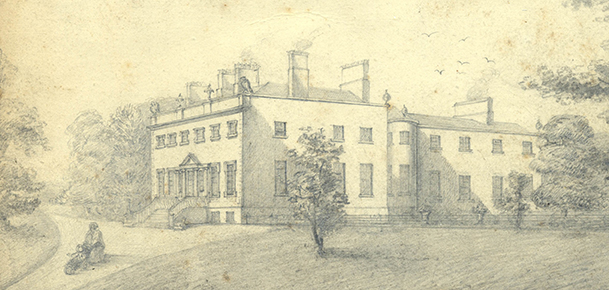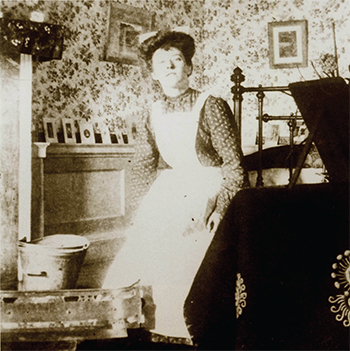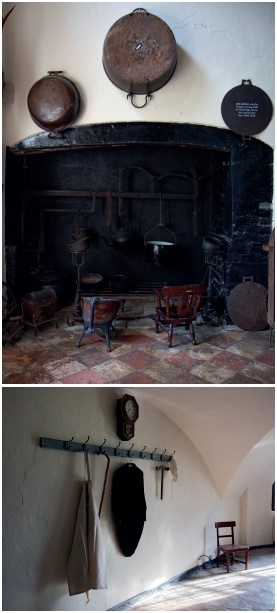Life downstairs in Newbridge House
Published in Features, Issue 6 (November/December 2020), Volume 28What the recently refurbished basement rooms of Newbridge House, Co. Dublin, reveal about servants’ lives in one of Ireland’s ‘big houses’.
By Cathal Dowd Smith
A country house can be defined as a place of two halves, like the analogy of the swan—a serene upper level kept afloat by a lot of hard work below. The two halves exist symbiotically, the family and their staff together constituting the ‘country house’ as a whole. Yet the historiography has to date focused chiefly on the upper half to the neglect of ‘downstairs’.
This imbalance in scholarship is no doubt due to the fact that the prevailing architectural merits of the country house reside mostly in the grand rooms upstairs. The fate of Ireland’s servants’ quarters has been mixed. In more recent times these spaces have often been sacrificed to the modern essentials required in maintaining a large house. At Castletown House, Co. Kildare, the coffee shop now occupies the old kitchen, while in County Waterford the historic stables of Curraghmore estate have been repurposed as a productive distillery. In less fortunate circumstances, where a country house has not survived, often the domestic and ancillary buildings are all that remain. St Anne’s Park in Dublin’s Raheny is littered with small follies and outbuildings, while the Italianate villa was demolished in 1968. The stables, designed by George Coppinger Ashlin (1883–7), were spared dereliction and now serve as a coffee shop, a mere reminder of the estate’s former architectural splendour.

Above: A drawing of the south and east sides of Newbridge House c. 1856 by Frances Power Cobbe. The house was built in 1747 by the archbishop of Dublin, Charles Cobbe, to the designs of James Gibbs, and was lavishly extended by his son, Thomas, from 1764. (Alec Cobbe)
An unaltered series of servants’ rooms
Newbridge House, Donabate, Co. Dublin, is perhaps one of the country’s best-preserved houses in public ownership, boasting a complete interior, intact parkland and partly resident original family. Below stairs, Newbridge possesses one of the most unaltered series of servants’ rooms. Among the vanities of the basement are the bright, well-proportioned work rooms, with views over both lawn and courtyard. These spaces boast vaulted ceilings and original Georgian woodwork painted in an idiosyncratic Venetian red. They are also unspoiled by what Hermann Muthesius noted as ‘veritable networks of pipes … pipes of every kind for hot water, heating, electric lights’, likening such houses to ‘complex organisms with arteries, veins and nerves’. Instead, at Newbridge the basement passageways retain the same vistas as would have been found in the eighteenth and nineteenth centuries. The survival of the architectural space should be celebrated alongside that of the extensive Cobbe family archives, from which the wage records, anecdotes and lives of three centuries of servants can be explored.
Recalling the 1840s, Frances Power Cobbe, daughter and one-time chatelaine of Newbridge House, wrote of her attempts to curtail unaccounted expenses downstairs:
‘I think the only sort of tyranny with which I was charged when I kept my father’s house, and which provoked violent recalcitration, was when I gave orders that men coming from our mountains to Newbridge on business with “The Master” should be served with largest platefuls of meat and jugs of beer, but should not be left in the Servants Hall en tête-à-tête with whole rounds and sirloins of beef, of which no account could afterward be obtained.’
A vivid picture is painted of the extensive tradition of hospitality on offer at Newbridge. Such a munificent welcome highlights the servants’ hall as the centre of the domestic hub for the staff, tenants and tradesmen engaged in the life of the Irish country house. William Thackeray, who visited Ireland in 1842, wrote of the ‘immense following of the Irish house, such as would make an English housekeeper crazy’. Newbridge was no different in the hospitality offered nor the extensive (if excessive) number of staff employed. Visitors to Newbridge today can note that the main entrance to the basement, which would have channelled all workers from the farmyard, dairy, forge, stables and gardens outside, not only opens into what would have been a busy passageway but also faces directly into the servants’ hall. It was here, Frances notes, where ‘the poor people were welcome to come and eat and drink … on every excuse or without any excuse at all’.
Household accounts

Above: An early twentieth-century image of a Newbridge housemaid cleaning out a bedroom fireplace. Such a close-up everyday image of a domestic servant is rare. (Alec Cobbe)
The household accounts offer a rich insight into the servants who lived cheek by jowl with the Cobbe family. As might be expected, the household was not without its moments of disquiet over the three centuries. On 6 December 1784 Thomas Cobbe notes the dismissal of his wife’s maid and housekeeper—‘Mrs Anne … Dis[charge]d. to the general joy of ye family’. Some of the best records of servant life, however, were created during the family’s absence. Following the departure of Thomas and Lady Betty Cobbe to Bath in 1785, at first for the winter months and increasingly for the greater part of the year, they maintained a skeletal staff of five. These three men and two women maintained the estate and unoccupied house in the absence of the full household. Like many of those employed in the eighteenth century, their roles were ambiguous and ill-defined. The account books of Thomas and Lady Betty show that they liked to travel with their cook, butler and personal attendants. Those left behind consisted of everything from housemaids and kitchen maids to farm and stable workers. These staff, of a junior but no less trusted rank, were employed from 1785 until 1809 on ‘board wages’. Board wages were specifically adjusted weekly wages which accounted for the buying of food, not provided for in the family’s absence. Unsurprisingly, we find the staff purchasing produce from the Newbridge farm. Their wages acted to redeem food, in the fashion of a circular economy within the Newbridge estate. Alternatively, desire might have played as large a part as convenience or obligation in their consuming. One frequent purchase by servants was of butter from the Newbridge dairy. This was the butter preferred by the Cobbes for its saltiness, and regular parcels of it were sent to Bath.
Paternalism
The paternalism shown by the Irish landed class to tenants and employees has been remarked upon not least by Patricia McCarthy, who notes that their houses were ‘remarkable for the numbers of servants and various hangers-on, some of whom were given odd jobs for payment in kind’. Again, Newbridge was no different. Despite the Cobbes’ absence, charity still prevailed at home in the form of a weekly allowance to two former maids, Margaret Keogh and Ally Mathews. This paternalism followed Christian lines, and in return for their allowances Keogh and Mathews sporadically performed various household tasks, such as ‘milking cows’ and ‘washing’, for which they were also paid. The idea of the allowance must have been to keep these two maids in loyal connection to the house despite there not being enough full-time work to occupy them. By January 1797 the staff on board wages had fallen to just two, Thomas Tyrell and Betty Montgomery. So it remained until May 1808 when Betty retired, a fact shown by the transfer of her name from the wages lists to those in receipt of an annuity, which she continued to receive until 1823.
In 1810, taking over Newbridge from his aged grandparents, Thomas and Lady Betty, Charles Cobbe spent a staggering £114-10-0 on ‘Servants Cloaths & expense of dress’. This bill was as substantial as the £118-6-0 spent on the servants’ wages that year. As a result of Cobbe’s grandparents’ retirement to Bath, he had inherited a house of faded Georgian grandeur in need of modernisation and investment—particularly, it seems, in the sartorial arrangements of the household staff.
‘Distinct topographical division’

Top: The original eighteenth-century
kitchen hearth. (Ailbhe Sheridan)
Above: Bright and well lit, the servants’
dining hall—where it was advised that visitors should receive their hospitality but not
be left unattended with expensive cuts of
meat. (Ailbhe Sheridan)
Christina Hardyment talks of the ‘distinct topographical division’ absent in medieval homes but mastered by the eighteenth century. This ‘lucid logic’ of servants’ living and working quarters separated both spaces for convenience and comfort—namely the convenience of the servant and the comfort of the master. James Gibbs’s 1740s Palladian villa design for Newbridge saw the offices, storerooms and bedrooms of the staff arranged in the basement, with a proposed forecourt extending kitchens and stables at length from the main house. By the 1760s the forecourt was still non-existent, the ancillary buildings, including kitchens, instead grouped around a courtyard to the rear north-west corner of the house. George Semple in his 1764 extension of Newbridge included a ‘high-spec’ labyrinth of passageways off which were a butler’s pantry, servants’ hall and housekeeper’s room and which terminated in a kitchen, with maids’ bedrooms above.
In 1810 Charles Cobbe found not only the servants’ sartorial needs but also their accommodation in need of improvement. The 1821 inventory lists accommodation within the house for coachmen, housemaids, footmen, the butler and the cook. In addition, Cobbe established five dwellings (at least three were new constructions) around the estate to house servants. Four such gate lodges for a peppercorn rent of £1 per annum became home to various carpenters, gardeners, herds, butlers, grooms, coachmen and their families. Deirdre Madden in her survey of north Dublin servants has shown that of 122 servants recorded in Fingal in 1901 nineteen of them were living and working at Newbridge. Most significantly, Madden has proven that these servants enjoyed a better class and condition of accommodation than those of any other Fingal estate in the 1901 census.
The Castle lodge, located in the south-west corner of the park and named for its proximity to the ruin of Lanistown Castle, was a gate lodge of c. 1810 consisting of four rooms and two outhouses. William Smith, gamekeeper, lived there from 1859 to 1906 with his wife and nine children. Upon Smith’s death, the occupancy of the lodge passed to his son, Andrew, the newly appointed gardener at Newbridge. In this house his six children were born, while Andrew’s brother, James, succeeded their father as gamekeeper and occupied the lodge at the Donabate gate. Three generations of one family living and dying in service on one estate can only bespeak a dedicated and contented workforce.
The records speak of a pleasant working environment created by successive generations of the Cobbe family at Newbridge. From the beginning, through investing in clothes, paying annuities after retirement and maintaining comfortable lodgings around the estate, there sprang up a community of the domestic servants, farm workers, estate managers and their families. The history of Newbridge as told through the lives of its servants goes beyond the architecture of handsomely proportioned, bright and comfortable rooms. It is the history of an industrious, hard-working and loyal staff who populated the basement, courtyard and estate of Newbridge, like so many other estates across Ireland whose ‘downstairs’ stories are yet untold.
Cathal Dowd Smith is an architectural historian and curator of Newbridge House and Farm. See newbridgehouseandfarm.com for opening hours.
FURTHER READING
C. Hardyment, Home comfort: a history of domestic arrangements (London, 1992).
M. Hearn, Below stairs: domestic service remembered in Dublin and beyond, 1880–1922 (Dublin, 1999).
P. McCarthy, Life in the country house in Georgian Ireland (New Haven & London, 2016).
















